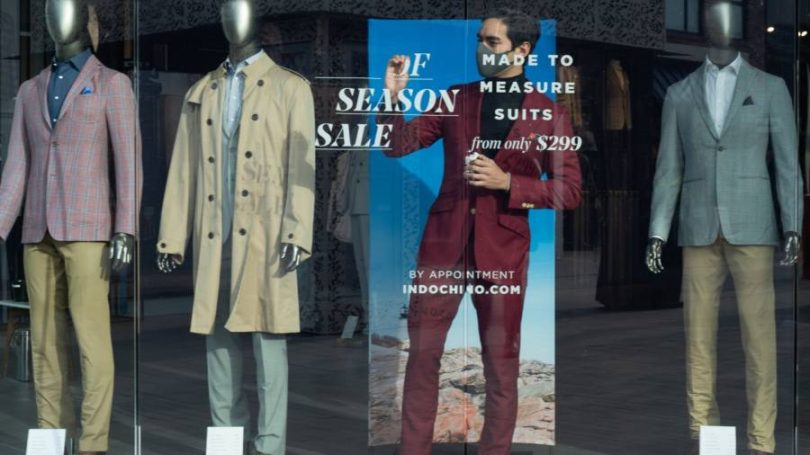[ad_1]
US apparel retailers are preparing steep markdowns to clear shelves ahead of the critical holiday season, as inflation pushes consumers to pull back on discretionary spending and wait for deals.
Clothing stores are battling a glut of inventory and a split in spending habits, as lower-income shoppers put necessities including food and rent first while affluent consumers replace pandemic leisurewear with tailored office outfits and wardrobes for going out.
“I hesitate to call it a bloodbath, but it’s going to be ugly in terms of the amount of discounting and markdowns,” said Urban Outfitters chief executive Richard Hayne on the company’s earnings call last month. Retailers are faced with too much product “across the board”, he warned.
Retail sales for clothing and accessory stores have remained largely flat for the past year, according to Census Bureau data. That is even though apparel prices were up 5.1 per cent year on year in August, according to US Bureau of Labor Statistics data.
But inflation is beginning to dent demand, with 85 per cent of American adults saying rising prices have changed the way they shop, pushing consumers to hunt for deals, discounts and coupons or simply to shop less, a new report from polling group Morning Consult showed.
That is putting retailers in a tough position. Many have more inventory than they need after supply-chain snarls caused goods ordered for last year’s holidays to arrive late. Many moved up orders this year ahead of their busiest selling season.
“There is too much inventory out there even if you adjust for retailers [that have] received goods earlier than normal,” said UBS retailing analyst Jay Sole.
Numerous retailers reported surging inventories for the second quarter: Foot Locker, Kohl’s and Gap reported inventories up 52 per cent, 48 per cent and 37 per cent, respectively.
“Retail historically has discounted when inventory was slow,” said Simeon Siegel, managing director of equity research at BMO Capital Markets. “But retail has not had a historical version of 2020, 2021 and 2022.”
Some retailers are choosing to carry more stock after being left short last year. Lululemon’s inventory was up 85 per cent year on year, but its comparable sales were up 23 per cent. Others are having to discount aggressively.
Abercrombie brand Hollister recently ran a website promotion for jeans at $20 a pair. Gap splashed multiple offers across its website including an additional 50 per cent off items already on sale.
American Eagle cleared its excess spring and summer merchandise by resorting to sales that hit profits by $30mn. “This is clearly an unprecedented time in retail,” said chief executive Jay Schottenstein on its latest earnings call.

A stark divide is emerging between discount and luxury brands as the holiday season — which stretches from Halloween to New Year — approaches.
Low-income shoppers are struggling with inflation, said Burlington Stores chief executive Michael O’Sullivan. “The current level of promotional activity will not last for ever. But while it does, it will create a very significant headwind for us,” he said.
Urban Outfitters, which also counts higher-end Anthropologie and Free People among its brands, said customer behaviour at its brands has split, with “affluence being the differentiator”. Younger, lower-income customers were spending “much more cautiously on discretionary items and often waiting for promotions before buying”, Hayne said.
That bifurcation is evident as “luxury, in general, is doing really well”, said Jessica Ramírez, senior research analyst at Jane Hali & Associates. Lower-end brands will see more of a “setback in consumer shopping”, she said.
Gina Drosos, CEO of jewellery retailer Signet, told the FT the split in consumers’ fortunes was clear from the differing demand for “value” and luxury-priced products. “The worst is under $250, the second worst is under $500 and the third worst is under $1,000,” she said: “The best is over $10,000.”
This year’s inventory challenges already look likely to affect next year’s results as retailers including Gap, Kohl’s and Lands’ End turn to “pack and hold” strategies — banking on basic styles like short sleeve T-shirts that can be brought back out and sold at later dates.
Lands’ End CEO Jerome Griffith said it could carry over some basic spring and summer items but for more fashion-oriented items “we want to take advantage of the promotional activity out there”.
Apparel stocks have underperformed the wider market. So far this year shares of American Eagle are down about 57 per cent, Abercrombie is down almost 56 per cent, Gap is down over 48 per cent and Urban Outfitters is down over 26 per cent. The S&P 500 is down almost 19 per cent so far in 2022.
This would be a tough year as retailers tried to get inventory in line with sales growth, UBS’s Sole said. “The state of play is retailers will try to use the rest of 2022 to put themselves in position for a more normal 2023,” he said.
[ad_2]
Source link








